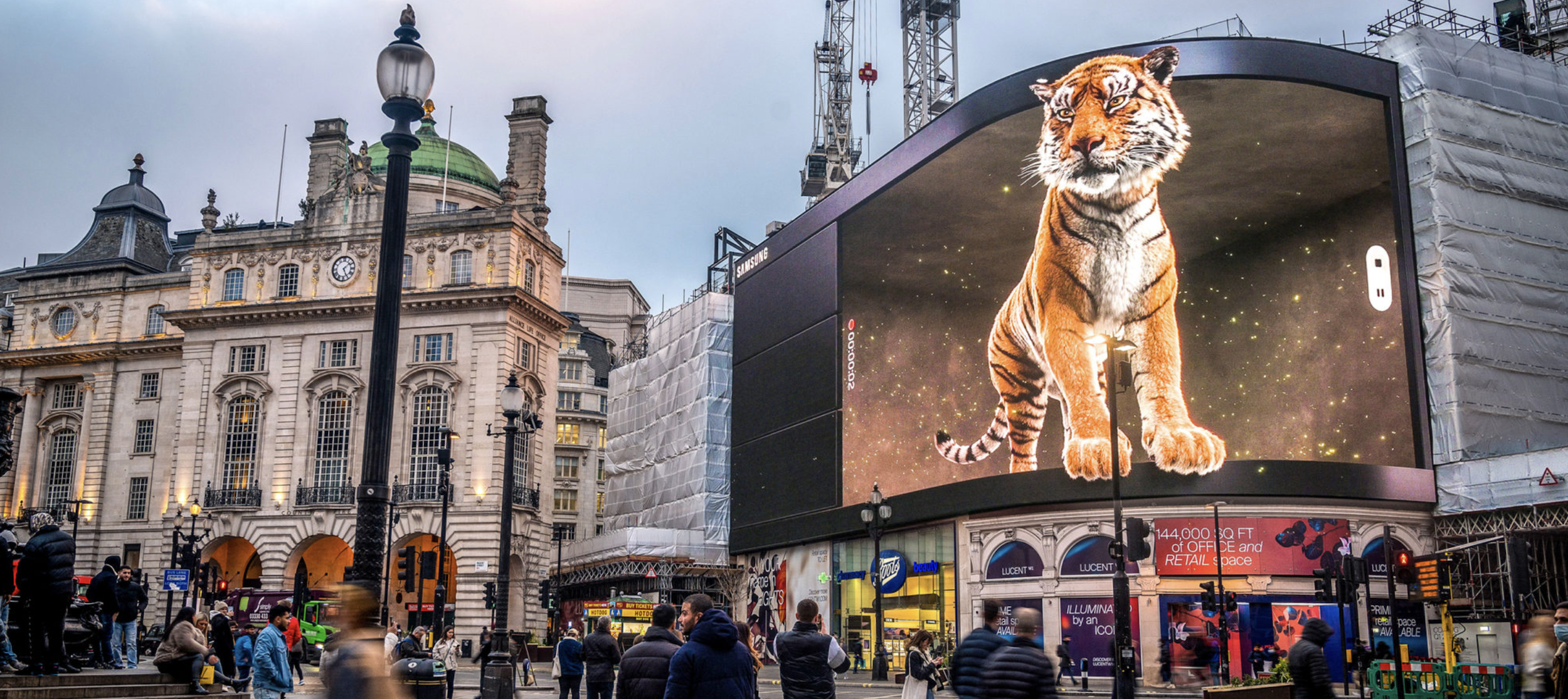
Credit: Ocean Outdoor UK Ltd
The average individual is exposed to some 6,000 to 10,000 ads on a daily basis. The attention economy is saturated; standing out and capturing consumer attention has never been harder. Brand managers, experiential agencies and creative directors need to invest in high-impact solutions to elevate their brand storytelling and resonate with audiences. Research indicates that 3D visualization boosts consumer engagement by enhancing attention and memory retention—serving as a critical way for brands to distinguish themselves from the competition. With this in mind, 3D billboards present an effective way to reach consumers at scale.
Digital 3D billboards bring IP to life in visually engaging ways and are a transformative force for creative campaigns and OOH advertising. Here, we’ll explore different types of 3D digital billboards and how they work. We’ll look into the impact this advertising medium can have on brand visibility, consumer engagement, and driving revenue.
Key Takeaways
- 3D digital billboards captivate consumers’ attention more effectively than traditional 2D ads. They offer memorable visual experiences, leading to increased brand engagement.
- 3D billboards unlock new possibilities for innovative storytelling. They allow brands to engage consumers emotionally and stand out in a crowded marketplace.
- Anamorphic, holographic, and AR billboards merge optical techniques and digital technology to create immersive, lifelike experiences.
- The integration of Augmented Reality (AR) and other interactive elements transforms 3D billboards from mere visual spectacles into participatory experiences.
- The effectiveness of 3D billboard advertising can be assessed through a combination of metrics. These include brand awareness, ad recall, conversion rates, and social media amplification.
Credit: Ocean Outdoor UK Ltd
What Is a 3D Billboard?
A 3D billboard leverages cutting-edge “naked eye” 3D image technology to create an illusion of depth. This makes the advertisement appear as though the subject is popping out or emerging out of the screen. Unlike traditional flat billboards, 3D billboards often incorporate LED screens and other technologies that give the featured images more volume and presence.
This advertising technique can prove particularly attention-grabbing as it makes the ad seem more lifelike and interactive. They are often designed to catch the eye of anyone passing through a high-traffic area, where they can cause a buzz and leave a lasting impression.
Let’s unpack a few different types of 3D billboards and how they work.
What Is a 3D Anamorphic Billboard?
A 3D anamorphic billboard creates an optical illusion, making a two-dimensional image appear three-dimensional when viewed from specific angles. This is achieved by using a distorted projection or artwork that—when seen from the correct vantage point—appears to pop out of the surface, essentially tricking the brain into perceiving depth and volume where there is none.
This form of advertising often engages passersby much more than standard two-dimensional billboards. One recent study by BCN Visuals revealed that a substantial majority (68%) of consumers find that these types of ads make brands seem more “premium”—and 66% are more likely to purchase the product thereafter.
Such billboards can be especially impactful in busy urban environments where they utilize the surrounding architecture and the movement of the audience to enhance the 3D effect.
What are Holographic Billboards?
Holographic billboards are advanced displays that use holography (wavefront reconstruction) technology to project 3D images into space without the need for special glasses. This gives the illusion that the images are floating in mid-air or are part of the environment. Holographic billboards aim to capture viewers’ attention with lifelike and interactive images that appear to move and change from different angles.
While anamorphic billboards are a technological illusion using a flat surface and 2D footage to create an optical illusion of depth and perspective, holographic billboards project a true 3D image. Using light diffraction to create these images, holographic billboards present the next step in out-of-home (OOH) advertising, offering a futuristic and engaging way to display content. They are particularly useful for creating experiential marketing campaigns.
Keep up to date
Sign up to our newsletter for exclusive updates and content, delivered directly to your inbox.
What are Augmented Reality Billboards?
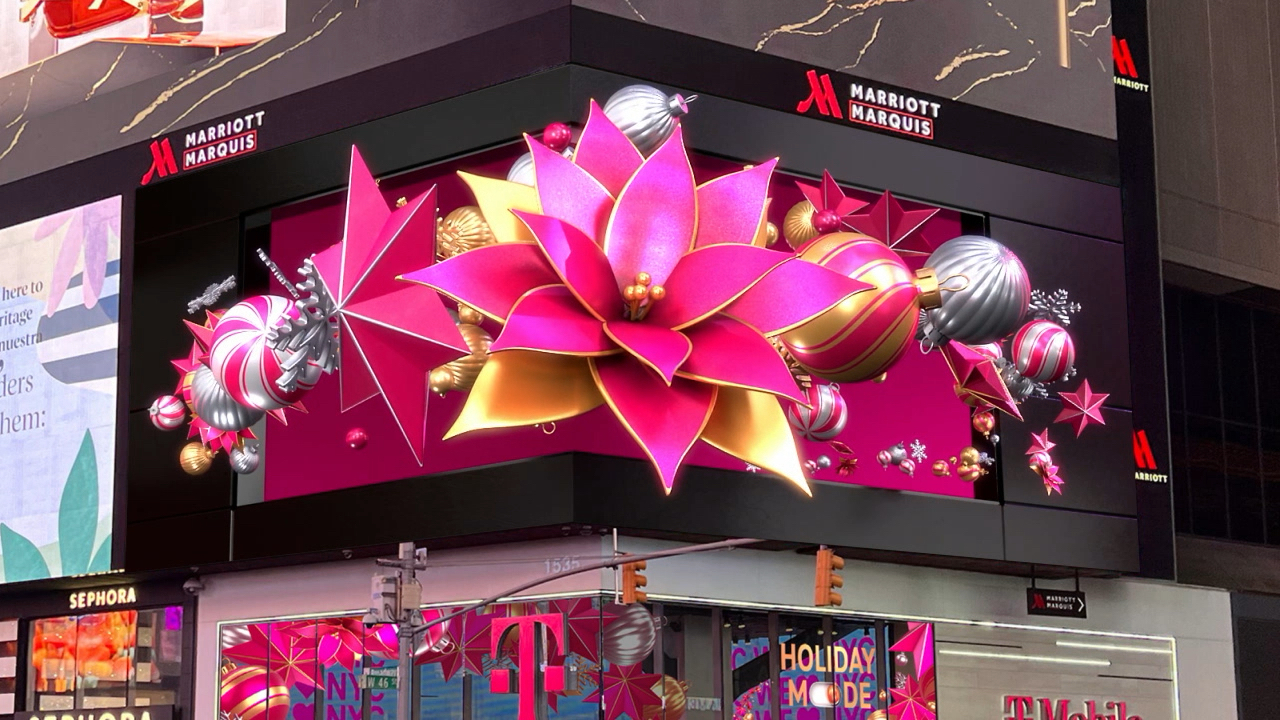
Credit: Rock Paper Reality/ Razorfish
An AR billboard is a form of digital out-of-home (DOOH) advertising that integrates digital technology to superimpose computer-generated images onto the real world. Unlike traditional billboards, users view AR billboards through a smartphone. The viewer scans a QR code or uses an app to layer virtual content over the real-life billboard.
These interactive displays can include animations, videos, or interactive games that users can engage with through their devices. AR billboards create a two-way interaction between the advertisement and the consumer. This creates a personalized experience and often includes a discrete call-to-action (such as visiting a website or accessing exclusive content). For example, T-Mobile worked with Rock Paper Reality to create an AR billboard for a campaign around the Holidays involving impressive 3D assets and animations. You can learn more about this later in the article.
The immersive nature of AR billboards makes them a powerful tool for capturing user attention and providing memorable brand experiences. This can lead to higher engagement rates and deeper emotional connections to the advertised product or service. In fact, research indicates that AR billboards can generate 400% more impressions than 2D static billboards.
Let’s chat
Not sure where to start? Book a free strategy call with us to get started! No strings attached.
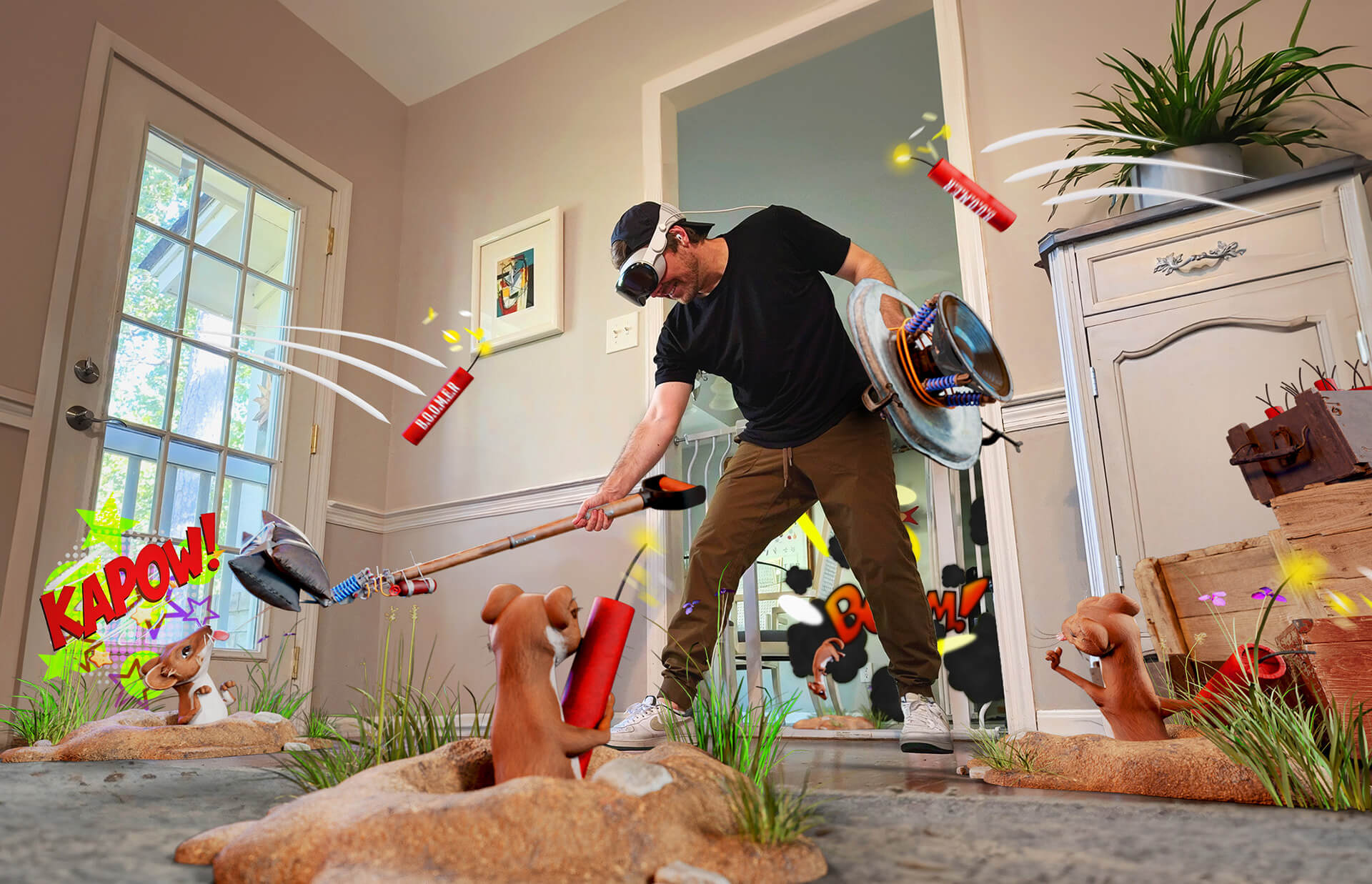
What Is the Difference Between 2D and 3D billboards?
2D billboards display flat graphics on a plane, offering no sense of depth, typically functioning as oversized, static printed ads. In contrast, 3D billboards create an illusion of depth and movement, often featuring physical extensions or digital technology that make images pop out, providing a lifelike and engaging experience to viewers.
While 2D billboards rely on creative graphics and text, 3D billboards leverage structural designs, lighting, and motion to capture and hold the audience’s attention in a three-dimensional space, offering a more immersive form of advertising.
What Is the History of Billboard Advertising?
Billboard advertising, an age-old marketing staple, has stood the test of time by reflecting consumer trends and technological advancements. From tall stone obelisks in ancient Egypt, merchants painting signs on walls and the printing of circus posters in 1835 to the first recorded leasing of billboards in 1867, billboard advertising can be situated within the wider evolution of OOH advertising over time.
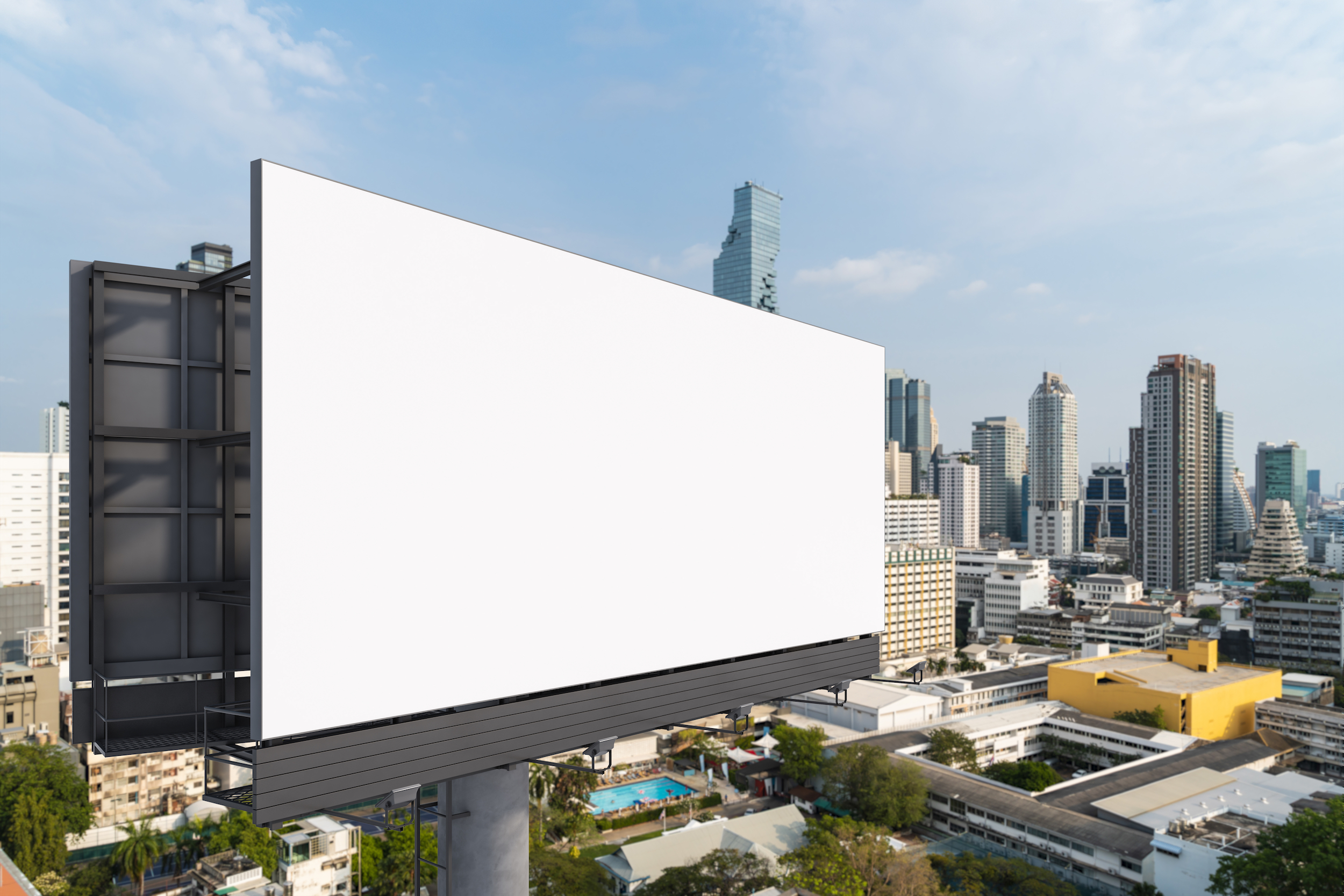
Key Milestones in Outdoor Advertising
The 1920s and 1930s marked outdoor advertising’s zenith, with brands like Coca-Cola and Lucky Strike capitalizing on billboards to reach a broader audience. This era saw a shift towards modernist design, characterized by stark typography and striking imagery.
In the digital age, outdoor advertising has evolved with the advent of LED screens and high-tech options that support dynamic, interactive, and targeted advertising. The introduction of digital billboards in 2005 marked a significant evolution in the field.
When Was the First Example of 3D Advertising?
A Norwegian studio premiered the world’s first digital 3D cinema ad without the need for special glasses on June 19, 2006. Designed for Mitsubishi cars, this pioneering ad launched at the Screen Advertising World Association (SAWA) event in Cannes, France.
3D advertising has only grown bigger and bolder since. Coca-Cola displayed both the first and largest dynamic 3D billboard at Times Square in August 2017. But Adler Inc. took Times Square record-breaking to a new level by displaying the world’s first real-time 3D ad on-location in May 2023. Visitors used a QR code on the billboard to instantly display personalized messages and tributes in 3D. Over 67,000 personal messages were displayed during the campaign.
How Do 3D Billboards Work?
3D billboards provide a dynamic platform for motion graphics, animations, and interactive displays, offering experiential agencies, advertisers and commercial directors an engaging and impactful playing field. As technology advances, the possibilities for creative and engaging 3D billboard advertising will only continue to expand, offering new ways for brands to connect with their audiences.
Perspective and Illusion Techniques
3D billboards harness optical illusions to trick the mind into seeing depth where there is none. Human eyes, positioned on opposite sides of the face, capture varied angles of the same view. By strategically manipulating angles and perspective, 3D billboards exploit this concept of stereopsis (combination of visual stimuli from both eyes) to engineer a sense of depth.
Creators skillfully blend art and science by merging two images taken from distinct angles. This creates an illusion that makes objects appear to leap out of the screen, a visual effect often referred to as forced perspective.
Physical Design and Construction
Bringing 3D billboard designs to life is a multi-step process. Graphic designers and artists use 3D modeling software or computer-generated imagery (CGI) to create detailed visuals. Photographing individual parts of objects for ultra-realistic effects may also be necessary. The final design is then optimized to fit the billboard’s size and shape, ensuring perfect integration in the display space.
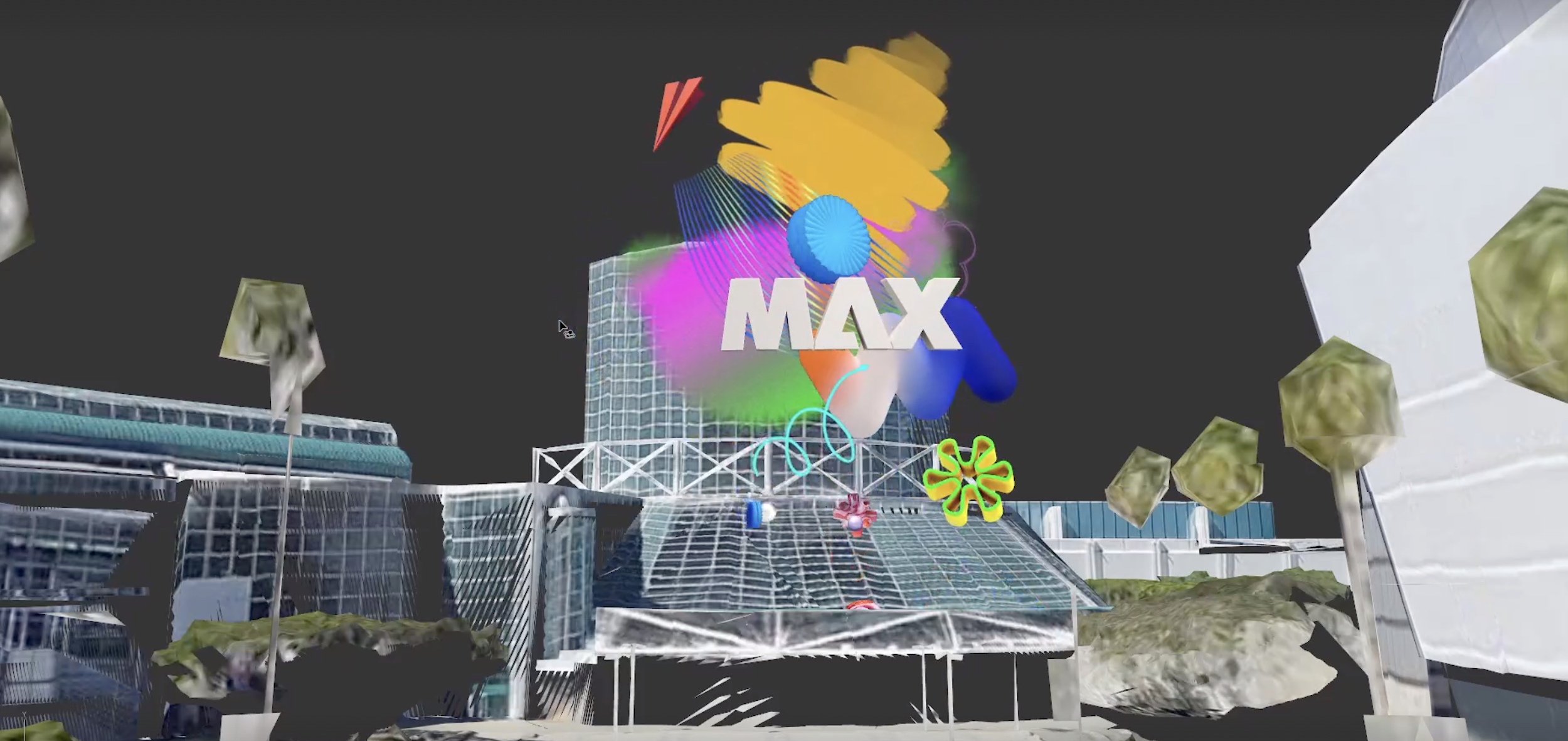
3D asset creation for AR/ Rock Paper Reality
A playback system incorporates high-resolution 3D content to manage rendering, ensuring accurate perspective, depth, and motion. It utilizes certain synchronization mechanisms for fluid transitions and unified playback across multi-unit billboards, consistently adjusting to maintain cohesion.
These screens usually have 4K resolution, offering a visual clarity similar to the latest high-definition TVs. High-resolution 3D displays offer more depth and realism. They display vivid colors with sharp definition thanks to 16-bit high grayscale technology, enhancing their ultra-realistic appearance. 3D digital billboards also auto-regulate brightness for clear visibility both day and night. Displays are designed to perform well in any weather, ensuring an always-optimal display.
What Are the Advantages of 3D Billboards?
Effective advertising hinges on recognizing how environmental factors shape people’s emotions and behaviors. Their surroundings influence their emotions and senses—which is why the disruptive and engaging nature of 3D billboards can have such a profound impact on someone passing by.
3D billboards represent a powerful tool for captivating and engaging consumers in an increasingly cluttered advertising landscape. Businesses are catching on too. In 2022, the number of digital billboards across the US increased by 14% to around 11,500 units—which equals a 28% growth (or around $2.64 billion) in ad spend. OOH advertising spend is expected to reach $8.68 billion by 2026.

How Can 3D Billboards Impact Consumer Engagement?
The impact of 3D billboards on consumer engagement is multifaceted. The 3D aspect not only makes the advertisement more noticeable but also more memorable, dramatically increasing ad recall. According to research from BCN Visuals, 50% of viewers are also likely to share an anamorphic ad experience with friends in person and even more (58%) via an app.
By breaking out of the traditional flat advertising canvas, 3D billboards provide a novel experience that can generate buzz. Furthermore, the immersive nature of 3D designs can evoke stronger emotional responses, which can influence purchasing decisions and brand loyalty.
Particularly compelling 3D billboards can sometimes become landmarks in their own right, drawing additional foot traffic to their vicinity—which can be beneficial for nearby businesses. With the integration of interactive elements such as QR codes and Augmented Reality, these billboards can offer an even deeper level of engagement, serving as gateways to digital campaigns and extended brand stories.
What Are Some Examples of 3D Billboards?
Thanks to a towering, impressive 3D billboard at Tokyo’s Shinjuku Station, the crossing has become the home of the famous giant Shinjuku cat. The 3D cat engages travelers and pedestrians from its 1600 square foot perch; it even has its own live stream feed and a Twitter account with 17,000 followers.
In 2014, Nike Japan enlisted the famous cat’s help to celebrate its 35th anniversary and launch the Air Max sneaker line, taking over the 3D billboard at Tokyo’s Shinjuku Station. The advertisement opened with a giant Nike box sliding onto the street. Various Air Max models then emerged and seemingly suspended in mid-air next to the billboard. With an array of designs and colors showcased, the ad wrapped up as the Nike box retracted into the billboard, assisted by the iconic Shinjuku cat’s paw.
Nike Air epitomizes creativity, imagination, and innovation. Its aim was to reflect this pioneering ethos with technology that excites both sneaker enthusiasts and the casual observer.
Meanwhile Meta, the company behind Facebook, unveiled an eye-catching 3D billboard in London’s Piccadilly Circus to promote the Meta Quest 2 headset in November 2022. The advertisement, featuring a lifelike NFL player catching a ball and an astronaut drifting out of the display, aimed to encourage purchases of the VR device. Meta views the VR headset as a key entry point to the metaverse, a virtual realm into which the company is pouring billions of dollars. You can see a video of the 3D billboard at the beginning of this article.
How to Measure the Effectiveness of 3D Billboard Advertising
The potential of these novel DOOH advertising approaches is clear—but how exactly can commercial directors and creative agencies measure the impact of running 3D billboard campaigns?
Tracking the effectiveness of 3D billboard advertising in the wild involves a multi-faceted approach that considers both quantitative and qualitative data. Some key performance indicators (KPIs) to pay close attention to include:
- Foot traffic and views — Advanced tracking technology can estimate the number of people who pass by a 3D billboard. This can provide raw data on potential impressions.
- Social media and hashtags — To monitor engagement, campaign managers can track metrics such as the usage of a campaign hashtag, follower count fluctuations, and mentions and shares of the outdoor advertisement across social media.
- Recall and recognition — Surveys and studies can be conducted to understand how well people remember the advertisement and the brand after seeing the 3D billboard.
- Conversion rates — If a 3D billboard campaign is tied to a specific CTA, tracking the number of actions taken—such as website visits or product purchases—can offer insight into its effectiveness. Placing a billboard on the way to a store, for instance, can increase foot traffic. Sales can be monitored before, during, and after the campaign to measure impact effectively.
- Brand perception — Changes in brand sentiment or recognition before and after the campaign can reveal the impact of the 3D billboard on brand image.
- Return on investment — Comparing the cost of the billboard campaign with the revenue generated from it provides a direct measure of financial effectiveness.
How to Create Engaging 3D Billboard Experiences
3D billboards transform passive observation into an active, engaging experience. These multidimensional canvases enable brands to weave narratives that captivate and resonate with audiences on a visceral level.
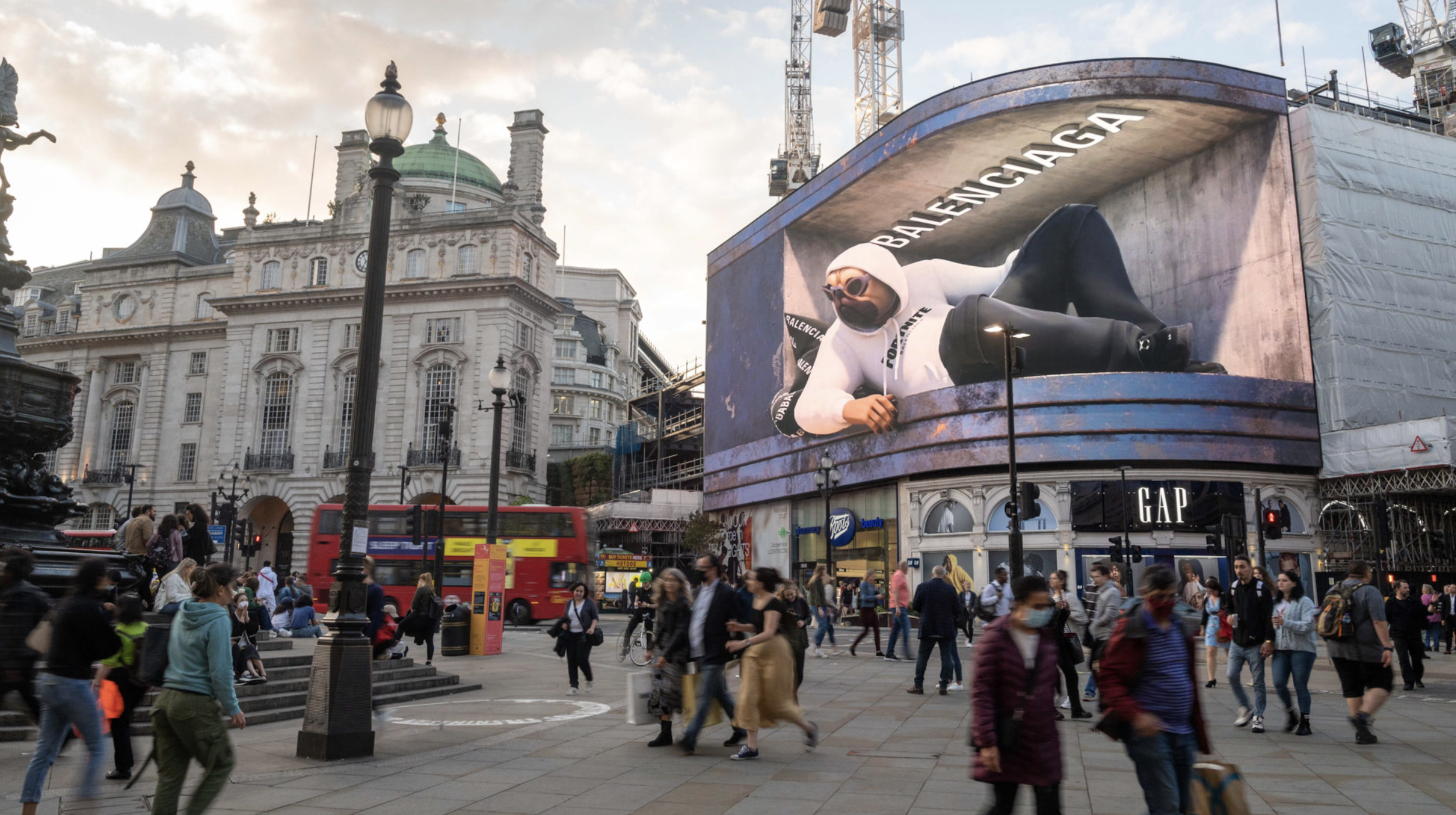
Credit: Ocean Outdoor UK Ltd
Essential Considerations for Designing 3D Billboard Ads
Of course, to employ 3D billboards effectively, there are some best practices and crucial factors to consider:
- Visually Striking Design — A visually striking design is necessary to capture viewers attention from various angles and distances. However, simplicity is also key. A clear and concise message will likely have a greater impact than a complex and overwhelming one.
- Contextual Relevance —The ad needs to speak to the local audience and fit the environmental context. It’s important to understand cultural nuances and the immediate physical surroundings where the billboard will be placed. This avoids visual dissonance and ensures the ad augments rather than disrupts the space.
- Engagement Strategy — Consider how the billboard will engage the audience. Will it include interactive elements, social media tie-ins, or evoke a strong emotional response? Engagement strategies should align with the brand’s overall narrative and marketing goals.
- Practical Execution — It’s important to balance ambitious designs with executional practicalities. Consider the technological aspects, such as the materials used for the 3D effects, the durability of the installation, and any digital interfaces that need to be incorporated.
- Legal and Regulatory Compliance — Different regions have different regulations regarding outdoor advertising, including safety, lighting, and community standards. Compliance with these regulations is not only a legal necessity but also a social responsibility.
How to Integrate Interactive Features and Immersive Technologies into 3D Billboards
Interactive features and immersive technologies transform passive onlookers into active participants, creating a layered experience. For example, a QR code on a 3D billboard can unveil an Augmented Reality experience. In cases where QR codes aren’t practical, inviting viewers to engage further on social media or with campaign hashtags can also be effective.
T-Mobile, for instance, celebrated the holidays by leveraging AR to take over Times Square and lead participants on a scavenger hunt. The brand collaborated with Rock Paper Reality, specialists in immersive creative technology, to develop the experience.
The campaign overlaid branded digital content onto existing LED billboards in Times Square. Scanning a QR code activated an Augmented Reality experience, causing a virtual festive tree to disperse ornaments. The captivating user interface not only held the attention of users, but also directed them to finish the game.
Future Trends and Innovations in 3D Billboard Advertising
3D billboards stand at the forefront of out-of-home advertising innovation, offering a compelling blend of engagement, storytelling, and interactivity. While the design and integration of such technology require careful consideration and a nuanced approach, the potential brand visibility and consumer engagement rewards are substantial. And the popularity of 3D advertising is only set to get bigger. The global 3D display market is predicted to undergo rapid growth, to generate $253.9 billion USD by 2026, from $48.21 billion in 2017.
Rock Paper Reality collaborates with agency and brand creatives to seamlessly integrate branded experiences into the digital layer. Our experts are ready to advise and guide brands from initiation to launch of 3D billboard projects. Let’s connect.
FAQs About 3D Billboards
What Is 3D Advertising?
3D advertising uses advanced technologies like AR and holography to create compelling brand stories. These narratives may feature interactive demos, virtual tours, or captivating visuals.
This cutting-edge strategy transcends traditional flat, two-dimensional ads by adding depth and dimension. Consumers are no longer just viewers; they’re immersed in an interactive world where products and messages come to life.
Why Do 3D Billboards Look So Real?
3D billboards appear to use visual techniques and advanced projection to craft depth and perspective. They merge a pair of subtly different images, each viewed from distinct angles. This deceives the brain into seeing objects as though they’re leaping out from the screen.
How Big Is a Billboard Sign?
Billboard ads vary in size, with the typical standard billboard measuring 14 feet tall by 48 feet wide. This offers plenty of room to display branding and messaging. Digital billboards, however, can come in many different sizes. Some ‘junior posters’ coming in as small as 8 feet tall by 25 feet wide, for instance.
